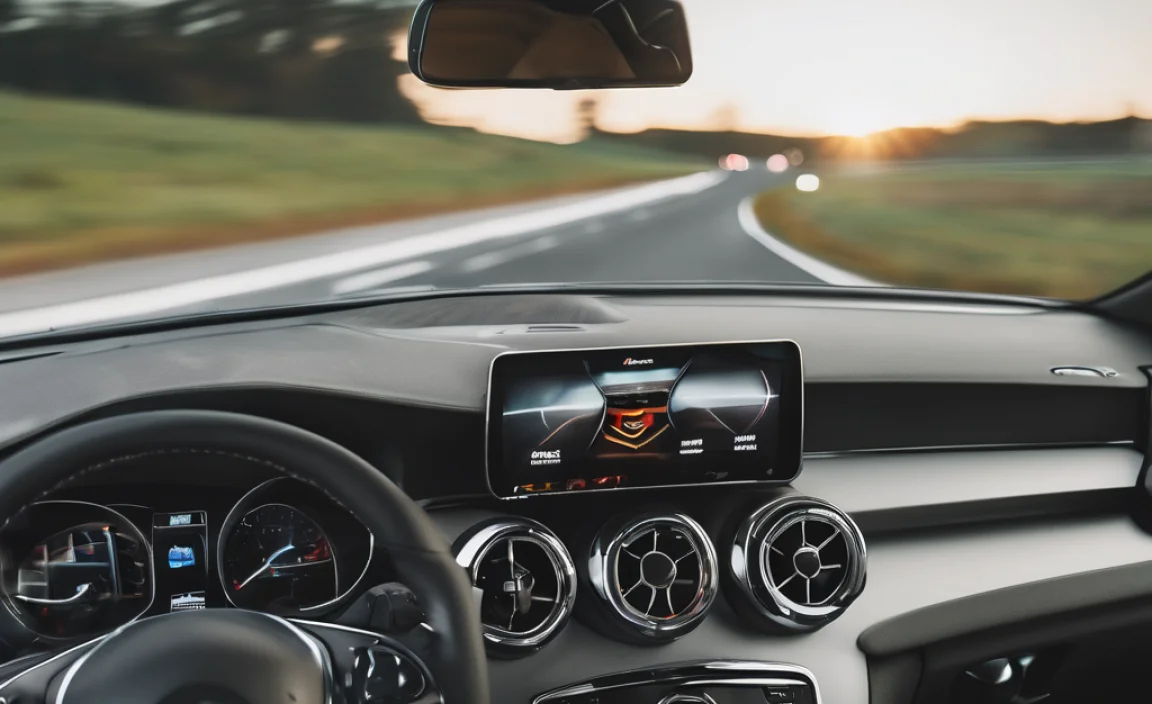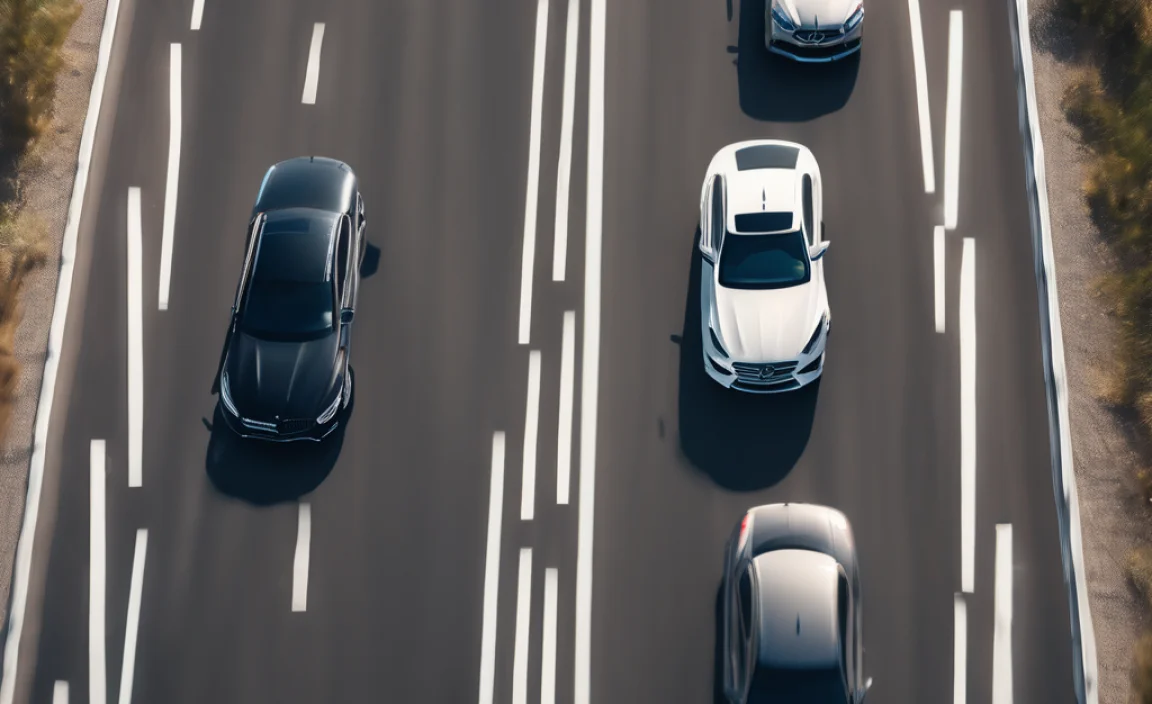GLA-Class Adaptive Cruise Control: Essential Guide
The GLA-Class Adaptive Cruise Control (ACC) system is designed to make your driving smoother and less tiring, especially on long journeys. Mastering its functions can significantly enhance your driving experience. This guide will walk you through understanding and effectively using your GLA’s ACC, ensuring you benefit from this advanced technology safely and confidently.
Understanding Your GLA-Class Adaptive Cruise Control
Many of us love our GLA-Class for its sporty feel and compact size, perfect for city driving. But what about those longer road trips? That’s where the magic of Adaptive Cruise Control (ACC) comes in! It’s like having a co-pilot that helps manage your speed and distance from the car ahead. We’ll break down exactly how this system works, what it can do for you, and most importantly, how to use it safely. You don’t need to be a car guru to get the most out of it. Let’s dive in and make your drives easier!
What is Adaptive Cruise Control (ACC)?

Adaptive Cruise Control, often abbreviated as ACC, is a sophisticated driver-assistance system that goes beyond traditional cruise control. While standard cruise control maintains a set speed, ACC actively adjusts your vehicle’s speed to maintain a pre-set distance from the vehicle in front. It uses radar or camera sensors to detect vehicles ahead and will automatically slow down your GLA-Class if you approach another vehicle too quickly, and then speed back up to your set speed once the vehicle ahead has moved out of the way or sped up.
Think of it as a smart cruise control that reacts to traffic. This feature is incredibly helpful in reducing driver fatigue on highways and in moderate traffic. It helps to maintain a safe following distance, which is a key aspect of safe driving, especially on longer trips. It’s not a fully autonomous driving system, however, and always requires your attention and input.
How ACC Works in Your GLA-Class

Your GLA-Class’s ACC system relies on a few key components working together seamlessly:
- Radar Sensor(s): Typically located behind the front grille or bumper, these sensors continuously scan the road ahead for other vehicles. They emit radio waves and measure the time it takes for them to bounce back, determining the distance and relative speed of the vehicle ahead.
- Camera(s): Often mounted near the rearview mirror, these cameras can identify lane markings and vehicles, supplementing the radar data. They help the system understand the road environment better.
- Control Module: This is the “brain” of the system. It processes information from the sensors and camera, and then sends commands to the engine and braking systems to adjust your speed.
When ACC is activated, it constantly monitors the road. If a vehicle ahead slows down, the system will apply the brakes gently to match its speed and maintain the set distance. If the vehicle ahead speeds up or changes lanes, and the lane ahead is clear, your GLA-Class will accelerate back to your previously set speed.
Benefits of Using GLA-Class ACC

Embracing ACC in your GLA-Class offers several advantages:
- Reduced Driver Fatigue: On long highway drives, the constant need to adjust speed for changing traffic conditions can be tiring. ACC automates much of this, allowing you to relax more.
- Smoother Driving: The system’s smooth acceleration and deceleration can lead to a more comfortable ride for you and your passengers, and can also contribute to better fuel efficiency.
- Enhanced Safety: By maintaining a consistent following distance, ACC helps reduce the risk of rear-end collisions, especially in highway traffic. It acts as an extra layer of awareness.
- Improved Traffic Flow: ACC’s consistent speed adjustments can help vehicles in traffic maintain a more uniform flow, potentially reducing instances of “stop-and-go” driving.
Limitations and Safety Considerations

It’s crucial to understand that ACC is a driver-assistance system, not a replacement for active driving. Here are some important limitations:
- Stationary Objects: Many ACC systems, including those in the GLA-Class, may have difficulty detecting stationary objects like construction barriers, stalled vehicles, or pedestrians. Always be prepared to brake manually.
- Sharp Curves: In very sharp turns, the sensors might momentarily lose track of the vehicle ahead. It’s best to disengage ACC or be ready to take over.
- Adverse Weather: Heavy rain, snow, or fog can interfere with the radar and camera sensors, potentially reducing the system’s effectiveness or causing it to deactivate.
- Motorcycles and Small Vehicles: Smaller vehicles or motorcycles might be harder for the sensors to detect consistently.
- Complex Traffic Situations: Merging traffic, vehicles cutting in, or sudden braking by multiple vehicles require your full attention.
Always keep your hands on the steering wheel and your eyes on the road. Your active supervision is essential for safe operation. For more detailed information on the safety systems in your Mercedes-Benz, you can refer to the official owner’s manual or consult the National Highway Traffic Safety Administration (NHTSA) guidelines on advanced driver-assistance systems.
Activating and Using GLA-Class ACC

Getting your GLA-Class ACC up and running is straightforward. The controls are usually integrated into your steering wheel, making them easily accessible. Here’s a typical process:
Step 1: Locate the ACC Controls
On your steering wheel, you’ll typically find a dedicated set of buttons or a toggle switch for the cruise control system. Look for symbols related to cruise control, speed, and distance.
Step 2: Activate the System
Press the “ON/OFF” or “Cruise” button to activate the ACC system. A symbol will usually appear on your instrument cluster, indicating that the system is ready.
Step 3: Set Your Desired Speed
Once the system is active, you can set your desired cruising speed. Use the “Set -” button (often by pushing down or sliding the toggle) to set your speed. This is the maximum speed your car will reach while ACC is engaged.
Step 4: Adjust the Following Distance
This is a key feature of ACC. You can select how much distance you want to maintain from the vehicle ahead. Look for buttons with car symbols and lines representing distance. Typically, there are several levels, from close to far. Choose a distance appropriate for the driving conditions.
Tip: On the highway in clear conditions, a medium to longer distance is recommended. In heavier traffic, a closer distance (but still safe) might be appropriate. Refer to the owner’s manual for specific guidance on your GLA-Class model.
Step 5: ACC Engages Automatically
As you drive, if you select “Set -” with sufficient speed, the ACC will engage and try to maintain that speed. It will then automatically adjust your speed based on the traffic ahead and the following distance you’ve set.
Step 6: Disengaging the System
There are several ways to disengage ACC:
- Braking: Pressing the brake pedal will immediately cancel ACC and apply the brakes.
- “Cancel” Button: There’s usually a dedicated “Cancel” button on the steering wheel. Pressing this will deactivate ACC without braking.
- “ON/OFF” Button: Pressing the main “ON/OFF” or “Cruise” button will turn the system off entirely.
Note: Simply releasing the accelerator pedal will not disengage ACC; the system will maintain the set speed or distance. Always be aware of how the system is operating.
Customizing Your ACC Settings
Your GLA-Class may offer additional customization options for the ACC system. These could include:
Adjusting Following Distance Levels
As mentioned, you can typically cycle through 2–4 different following distance settings. Experiment to find what feels most comfortable and safe for you in various scenarios.
Speed Limit Assist Integration
Some Mercedes-Benz models integrate ACC with Speed Limit Assist. This means the system can automatically adjust your set speed to match detected speed limits. This feature requires careful monitoring and understanding of its behavior.
Stop-and-Go Functionality
Many newer GLA-Class models are equipped with an enhanced ACC that can function effectively in stop-and-go traffic. This version can bring your vehicle to a complete stop behind the car in front and then resume driving automatically (within a certain time limit) once the traffic starts moving again. This significantly reduces the stress of commuting.
Troubleshooting Common ACC Issues
While ACC is generally reliable, you might encounter minor issues. Here are a few common troubleshooting tips:
ACC Unavailable/Unavailable Temporarily
Possible Cause: Sensor blockage (dirt, snow, ice), adverse weather, or system malfunction.
Solution: Check the front grille and sensors for any obstructions and clean them. Ensure weather conditions are suitable. If the issue persists, a warning light might appear on the dashboard, and you should consult your owner’s manual or a Mercedes-Benz service center.
Inconsistent Following Distance
Possible Cause: Difficulty tracking vehicles in sharp curves, sensing motorcycles, or complex traffic merging.
Solution: This is often normal system behavior in challenging situations. Always be prepared to intervene. If it happens frequently in normal conditions, it might warrant a check by a technician.
ACC Deactivates Unexpectedly
Possible Cause: System detects a potential fault, rapid deceleration causes the system to hand control back, or a sensor issue.
Solution: Note any warning messages on the dashboard. If it’s a recurring issue, have your vehicle inspected. Remember, the system prioritizes safety, and unexpected deactivation is often a sign it’s handing control back to you for a good reason.
Important Note: For any persistent or concerning ACC issues, never hesitate to visit your authorized Mercedes-Benz dealership. They have the specialized diagnostic tools and expertise to accurately diagnose and resolve any problems.
GLA-Class ACC vs. Distronic Plus: Understanding the Differences
Mercedes-Benz uses various names for its advanced driver-assistance systems. You might hear about “Distronic” or “Distronic Plus.” While they all fall under the umbrella of adaptive cruise control, there can be differences in functionality and sophistication depending on the model year and specific package installed on your GLA-Class.
Distronic generally refers to the adaptive cruise control function. Distronic Plus often indicates an enhanced version that might include features like Steering Assist (helping to keep the car centered in its lane) or Cross-Traffic Assist, working in conjunction with the ACC to provide more comprehensive semi-autonomous driving support.
Here’s a simplified comparison:
| Feature | GLA-Class ACC (Standard) | Distronic Plus (Enhanced) |
|---|---|---|
| Speed Adjustment | Yes | Yes |
| Following Distance Maintenance | Yes | Yes |
| Stop-and-Go Functionality | Model dependent, often available | Generally more robust |
| Steering Assist | Typically not included | Often included |
| Cross-Traffic Assist | Typically not included | Often included |
Always refer to your specific GLA-Class owner’s manual to understand the exact capabilities of the system installed in your vehicle. The technology is constantly evolving, with newer models offering more advanced features.
Best Practices for Using ACC on the Road
To maximize the benefits and safety of your GLA-Class ACC, follow these best practices:
- Always be Attentive: ACC is an aid, not an autopilot. Keep your hands on the wheel, your eyes on the road, and your mind engaged in the driving task.
- Know When to Disengage: Be ready to disengage ACC at any moment, especially in unpredictable traffic, bad weather, or when approaching complex intersections or construction zones.
- Proper Following Distance: Choose a following distance that is appropriate for current conditions. A longer distance is usually safer, especially in wet or slippery conditions. Remember, the system’s response is not instantaneous.
- Understand Sensor Limitations: Be aware that sensors can be affected by dirt, weather, or specific road geometries.
- Avoid Relying on it in City Driving: While Stop-and-Go functionality is helpful, constant braking and acceleration in dense urban traffic can be more efficiently and sometimes more safely handled by manual driving.
- Regularly Check for Updates: Ensure your vehicle’s software is up-to-date. Mercedes-Benz sometimes releases updates that can improve the performance and safety of its driver-assistance systems.
Learning to use your GLA-Class ACC effectively takes practice. Start by using it in familiar, low-traffic highway environments to become comfortable with its behavior before relying on it in more demanding situations.
Frequently Asked Questions (FAQ) about GLA-Class Adaptive Cruise Control
Q1: How do I turn on the Adaptive Cruise Control in my GLA-Class?
A1: You typically turn on ACC by pressing the “ON/OFF” or “Cruise” button on your steering wheel. Once activated, you’ll see an indicator on your instrument cluster, and you can then set your desired speed and following distance.
Q2: Can my GLA-Class ACC detect motorcycles?
A2: While ACC systems are designed to detect vehicles, they can sometimes have difficulty consistently tracking smaller vehicles like motorcycles due to their size and radar signature. Always remain vigilant, especially around motorcycles.
Q3: What happens if the sensors for ACC get dirty?
A3: If the radar sensors or cameras are blocked by dirt, snow, ice, or debris, the ACC system will likely become unavailable, and a warning message will appear on your dashboard. Clean the sensors (usually located on the front grille or bumper) for the system to function again.
Q4: Is GLA-Class ACC the same as autopilot?
A4: No. ACC is a driver-assistance system that helps manage speed and distance. It requires your constant supervision and intervention. True “autopilot” or full self-driving capabilities (like those found in some other vehicle brands) are not present in standard GLA-Class ACC systems. Always keep your hands on the wheel and your focus on the road.
Q5: Can ACC stop my car completely?
A5: Yes, many modern GLA-Class models with ACC feature a Stop-and-Go function that can bring the vehicle to a complete halt. The system may also automatically resume driving if the vehicle ahead moves within a few seconds. Consult your owner’s manual for the exact behavior of your specific model.
Q6: How do I adjust the following distance setting?
A6: You can adjust the following distance by using the dedicated buttons on your steering wheel, usually indicated by symbols of a car with lines or arrows showing different distances. Cycle through the options until you find one that suits the current traffic and road conditions.
Q7: When should I NOT use Adaptive Cruise Control?
A7: You should disengage ACC in heavy, unpredictable city traffic, during adverse weather conditions (heavy rain, snow, fog), on slippery roads, on sharp curves, when approaching construction zones, or when you are tired or distracted. It is primarily designed for highway driving in moderate conditions.
Conclusion
Your GLA-Class Adaptive Cruise Control is a fantastic tool designed to enhance your driving comfort and safety on longer journeys and in varying traffic conditions. By understanding how it works, its limitations, and how to operate it correctly, you can significantly reduce driving fatigue and enjoy a smoother, more relaxed ride. Remember, it’s an assistance system, and your active attention and readiness to take control are paramount for safe operation.
Take the time to practice using ACC in controlled environments, experiment with the different settings, and always refer to your owner’s manual for the most accurate information specific to your vehicle. With a little practice and mindfulness, you’ll soon be leveraging the full potential of your GLA-Class’s advanced cruise control technology, making every drive a more pleasant experience. Happy driving!